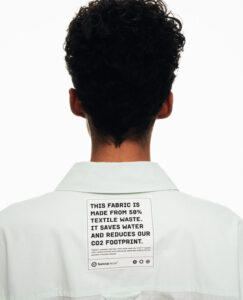H&M may just (somewhat) turn around the face of fast-fashion.
How so? And what can other players in this space emulate from their strategy?

So, H&M aims to be 100 per cent sustainable by 2030. Is this the fast-fashion-metamorphosing-into-slow-fashion story that we were waiting for? The din around fast fashion has been growing among a small but growing band of conscious consumers and what H&M says it is doing to turn sustainable may just upend the fashion business (as we know it) in the medium term (short term seems unrealistic and exudes more optimism than can be justified). So the timing is just fine.
What will happen by 2030, as per H&M’s statement to CauseBecause, is that all H&M products will be made from recycled or other sustainably sourced materials. Apparently this already applies to 57 per cent of the materials that the brand uses. At the moment, in order to qualify for a sustainable hangtag, a product must contain at least 50 per cent sustainable materials, such as organic cotton and recycled polyester. An exception is recycled cotton, which can only make up 20 per cent of a product due to quality restraints. The company says it is working with innovations to increase this share.
Alongside is the up-and-running Conscious concept: pieces created with ‘a little extra consideration for the planet’. They are made from at least 50 per cent sustainably sourced materials – like organic cotton and recycled polyester, though many Conscious products contain a lot more than that, as per the company spokesperson.
As a step towards being more transparent, the company is starting to share, wherever possible, how and where their products are made. Any available information for a particular product can be found in their new ‘Product Sustainability’ section on the product’s page on www.hm.com. Such information will tell us about a) the materials used to make the product – and the sustainability of the materials; b) the countries/place where the product was made; c) the supplier partner who manufactured the product; d) the factory/ies where the product was made; and e) recycling options for consumers.
The company’s website further states: Responsible purchasing practices are fundamental in safeguarding the fair treatment of garment workers and to provide a healthy work environment. Some key questions to ensure that you are a responsible buyer include: When will the supplier be paid for the goods produced? What will that price be, and what parameters will you negotiate that price on? What are the cancellation grounds and how are they regulated in contracts?

H&M’s latest sustainable kidswear capsule collection made with organic cotton, recycled materials and eco-responsible viscose
Buyers have an important responsibility to create an enabling environment for human rights to be properly respected and implemented in practice, for example by enabling timely payment for products ordered so that suppliers in turn can pay wages to all workers on time. Without adequate planning and responsible purchasing practices, the risk of overtime, late wage payments, and health and safety violations, increases significantly.
Good purchasing practices and supplier relationships will help to address challenges related to uneven production based on consumer demand. For example, the buyer can plan, together with the supplier, the capacity well in advance, to reduce excessive overtime for factory workers in peak seasons, and to plan for periods with less consumer demand.
The company agrees that working towards a sustainable fashion future is a big challenge and a long-term commitment. In their words: ‘Many of the challenges we face today are too complex to tackle alone. By joining a range of organisations and initiatives we can facilitate collaboration, increase our impact, learn, and together accelerate change. We want to produce only what we sell and are actively looking into leveraging technological advancements like AI along with circular innovations to drive our sustainability goals forward.’
Among their key collaborations are those with I:CO, a global service provider that collaborates with H&M Group to collect textiles from their in-store collection points, and with Ellen MacArthur Foundation and its Circular Economy 100 programme. As part of this programme, H&M is working with other corporates, governments and cities, academic institutions, emerging innovators, small and medium-sized enterprises (SMEs), and others to accelerate the transition to a circular economy. H&M Group is a Core Partner of the Foundation’s Make Fashion Circular initiative, and is also a signatory to the Foundation’s New Plastic Economy Commitment, which sets out three major goals in order to establish sustainable use of plastics.
H&M has been offering garment collecting and recycling service across all stores globally since 2013. Consumers can hand in unwanted clothes and textiles by any brand, in any condition, at any H&M store.
And here's a checklist for responsible brands.

